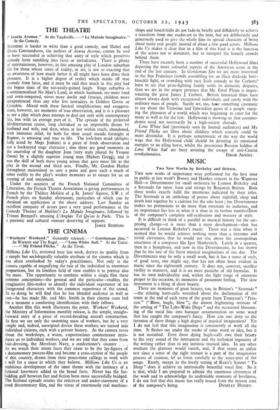THE CINEMA
" Workers' Weekend." Generally released. " Gentleman Jim."
At Warners and The Regal.—" Lone White Sail." At the Tatler. My Friend Flicka." At the Tivoli.
Millions Like Us, reviewed here last week, derives its quality from a simple but sociologically valuable attribute of the cinema which is too often overlooked by today's practitioners. Not only is the camera capable of magnifying the role of the individual to enormous proportions, but its limitless field of view enables it to portray also the mass. The opportunity to combine within a single film these extreme conceptions—the general and the particular—enables the imaginative film-maker to identify the individual experience of his foreground characters with the common experience of the crowd. In so doing he will find that he has blended audience as well as cast—he has made Mr. and Mrs. Smith in. their cinema seats feel for a moment a comforting identification with their fellows.
Another film this week illustrates the point. Workers' Weekend, the Ministry of Information monthly release, is the simple, straight- forward story of a piece of record-breaking aircraft construction. At first we see only the swarming mass of workers, but by a very simple and, indeed, unoriginal device these workers are turned into individual citizens, each with a private history. As the camera roves about the workshops, a warm, unpretentious commentator intro- duces us to individual workers, and we are told that they come from hair-dressing, -the Merchant Navy, a confectioner's counter . . As we watch their intent faces they cease to be the lay-figures of a documentary process-film and become a cross-section of the people of this country, drawn from their peace-time callings to work with a will for a cause in which they believe. Millions Like Us is 'an ambitious development of the same theme with the intimacy of a fictional love/story added to the broad facts. Never has the for- bidding gulf between fact and fiction been more successfully bridged. The fictional episode retains the reticence and under-statement of a good documentary film, and the vistas of enormously real machine-
shops and hostel-halls do not fade-in briefly and diffidently to achieve a transition from one studio-set to the next, but are deliberately and generously used to give the whole film its special character of being about many real people instead of about a few good actors. Millions Like Us makes it clear that in a film of this kind it is the function of the actors not to dominate, but to interpret the homely crowds behind them.
There have recently been a number of successful Hollywood films depicting the more colourful aspects of the American scene at the end of the last century. In Gentleman Tim we are more interested in the San Francisco crowds assembling for an illicit dockside bare- knuckle fight, or crowding with racy Irish comedy to the Corbetts' barn to see that prize-fighting family settle its domestic disputes, than we are in the empty pretence that Mr. Errol Flynn is imper- sonating the great James J. Corbett. British historical films have almost always dealt with exceptional individuals and rarely with the ordinary mass of people. Surely we, too, have something cinematic to say about the Victorian and Edwardian gusto of a people enjoy- ing the pleasures of a world which was beginning to cater for the many as well as for the few. Hollywood is showing us that costume- drama need not necessarily be a high-society charade.
Lone White Sail (previously seen by limited audiences) and My Friend Flicka are films about children which scarcely could be more dissimilar. It is perhaps symptomatic of the way the world wags that the Hollywood child should be devoting its emotional energies to an ailing horse, whilst the precocious Russian kiddies of Lone White Sail are busy assisting the escape of anti-Czarist


























 Previous page
Previous page